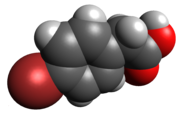Chemistry:4-Bromophenylacetic acid

| |

| |

| |
| Names | |
|---|---|
| Systematic IUPAC name
2-(4-bromophenyl)acetic acid | |
| Other names
p-Bromophenylacetic acid
2-(4-bromobenzene)acetic acid | |
| Identifiers | |
3D model (JSmol)
|
|
| ChEBI | |
| ChemSpider | |
| EC Number |
|
| KEGG | |
PubChem CID
|
|
| UNII | |
| |
| |
| Properties | |
| C8H7BrO2 | |
| Molar mass | 215.046 g·mol−1 |
| Appearance | White solid |
| Odor | Honey-like |
| Melting point | 118 °C (244 °F; 391 K) |
| Hazards | |
| Safety data sheet | External MSDS |
| GHS pictograms | 
|
| GHS Signal word | Danger |
| H318, H319 | |
| P264, P280, P305+351+338, P310, P337+313 | |
| Related compounds | |
Related compounds
|
Phenylacetic acid |
Except where otherwise noted, data are given for materials in their standard state (at 25 °C [77 °F], 100 kPa). | |
| Infobox references | |
4-Bromophenylacetic acid, also known as p-bromophenylacetic acid, is an organic compound. It is a derivative of phenylacetic acid containing a bromine atom in the para position.
Preparation
4-Bromophenylacetic acid may be prepared by the addition of a bromine atom to phenylacetic acid through electrophilic aromatic substitution. It was first prepared in the laboratory by treatment of phenylacetic acid with bromine and mercuric oxide; a mixture of the 2- and 4- isomers is made, and the 4- isomer is isolated by fractional crystallization.[1]
It can also be made by condensing 4-bromobenzylbromide with sodium cyanide in ethanol, and the hydrolising the nitrile with sodium hydroxide.[2]
Reactions
Methyl 2-(4-bromophenyl)acetate is made from 4-bromophenylacetic acid by refluxing it with methanol acidified with sulfuric acid.[3]
An ethyl ester can be made in an analogous way.[4]
A hydrazone derivative, 2-(4-bromophenyl)acetohydrazide, is made by refluxing the methyl ester with hydrazine.[3] Further hydrazone derivatives of 4-bromophenylacetic acid are made by condensing the simple hydrazone with aldehydes, forming a double bond with the second nitrogen.[3] At least 19 of these hydrazones are known.[3]
4-Bromophenylacetic acid is a chemical that can be purchased.[5]
Plant protoplasts conjugate aspartic acid with 4-bromophenylacetic acid to form 4-bromophenylacetyl-L-aspartic acid.[2]
4-Bromophenylacetic acid reacts with sodium tetraphenylborate to form felbinac which can be further converted to xenbucin.[4]
Properties
The ionic conductance has been measured.[6]
See also
References
- ↑ Bedson, P. Philips (1880). "VIII.—On some derivatives of phenylacetic acid". Journal of the Chemical Society, Transactions 37: 90–101. doi:10.1039/CT8803700090. https://pubs.rsc.org/en/content/articlelanding/1880/ct/ct8803700090. Retrieved January 19, 2023.
- ↑ 2.0 2.1 Aranda, Gérard; Muller, Jean-François; Caboche, Michel (January 1987). "Conjugation of aspartic acid with 4-bromophenylacetic acid, an auxin analogue of aspartic acid". Phytochemistry 26 (8): 2145–2147. doi:10.1016/S0031-9422(00)84675-0.
- ↑ 3.0 3.1 3.2 3.3 Khan, Imtiaz; Ibrar, Aliya; Ejaz, Syeda Abida; Khan, Shafi Ullah; Shah, Syed Jawad Ali; Hameed, Shahid; Simpson, Jim; Lecka, Joanna et al. (2015). "Influence of the diversified structural variations at the imine functionality of 4-bromophenylacetic acid derived hydrazones on alkaline phosphatase inhibition: synthesis and molecular modelling studies". RSC Advances 5 (110): 90806–90818. doi:10.1039/C5RA14836G. Bibcode: 2015RSCAd...590806K.
- ↑ 4.0 4.1 Kuuloja, Noora; Kylmälä, Tuula; Xu, Youjun; Franzén, Robert (1 September 2008). "Synthesis of Xenbucin using Suzuki reaction catalyzed by Pd/C in water". Open Chemistry 6 (3): 390–392. doi:10.2478/s11532-008-0044-1.
- ↑ Field, Jennifer A.; Reed, Ralph L. (1 November 1996). "Nonylphenol Polyethoxy Carboxylate Metabolites of Nonionic Surfactants in U.S. Paper Mill Effluents, Municipal Sewage Treatment Plant Effluents, and River Waters". Environmental Science & Technology 30 (12): 3544–3550. doi:10.1021/es960191z. Bibcode: 1996EnST...30.3544F.
- ↑ Holze, Rudolf (2016). "Ionic conductance of p-bromophenylacetic acid". Electrochemistry: 573. doi:10.1007/978-3-662-49251-2_540. ISBN 978-3-662-49249-9.

